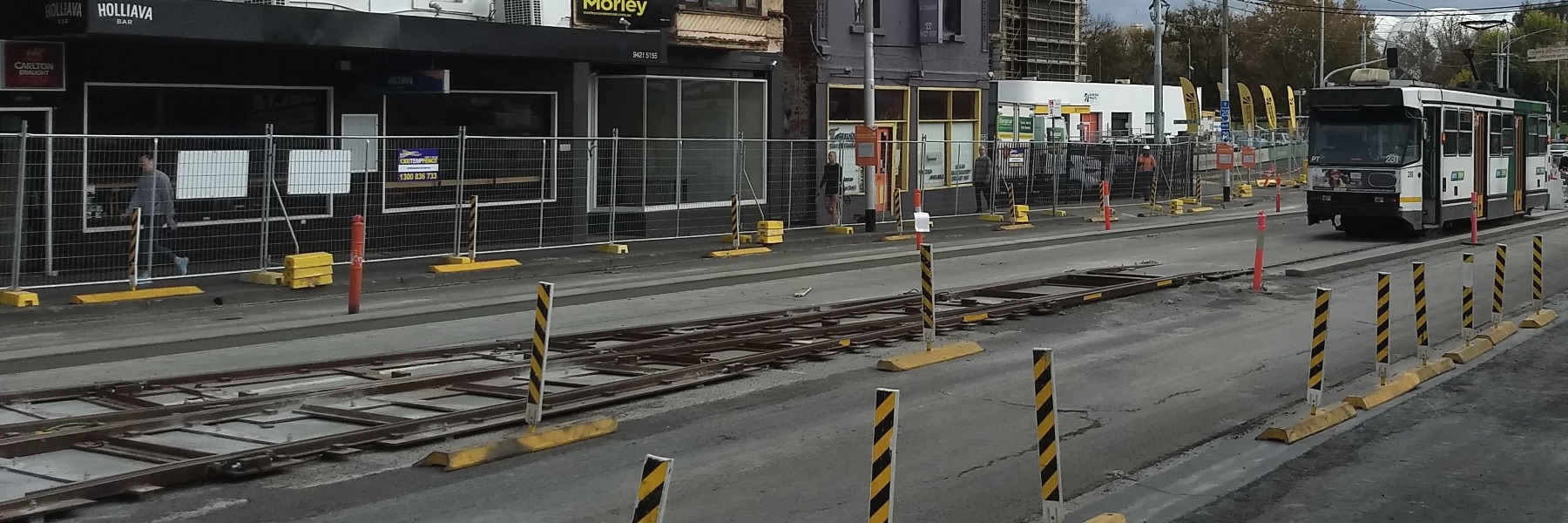I think this is quite clever.
When trains or trams are partially closed for planned works, generally the less of the route is disrupted, the better.
But this is always limited by the placement of turnaround facilities. Witness the current Sandringham line closure: the major works are at South Yarra, but because (despite what was said beforehand) the infrastructure issue at Elsternwick hasn’t been fixed, the whole line is closed.
Over on the trams, they have an ingenious solution: a portable, temporary crossover. It was in use in Swan Street in Richmond (route 70) for a few days this week while tram platform stops are built:
This enabled them to terminate trams at Richmond station, with disrupted passengers able to either change to a train, or walk 400 metres to where trams could resume.
Apart from placement of the temporary track, they also needed to install some overhead wire. Of course it’s made easier to manage in this case by the road closure.
But it’s smart thinking, allowing trams to run as far as possible, reducing disruption for passengers, and avoiding the mess and cost of replacement buses.
Temporary track is nothing new. Back last century it was a common occurrence around the tram (and train) networks. But that was in a bygone era, when I suspect labour was cheap.
For long term projects, it still sometimes happens. Over Easter, the Dandenong and Frankston lines near South Yarra were ripped up and rebuilt as part of Metro tunnel works, and will be ripped up again as the junction to the new tunnel portal is built. There have also been tram tracks relocated on St Kilda Road which may need to be relocated again as the tunnel works continue.
But overall, temporary track is less common in modern times, at least on short term projects.
If only it were this easy on the railways.

4 replies on “Temporary track to minimise disruptions”
Daniel,
Regarding the turn-around at Elsternwick, I doubt if the PTV ever intend to fix this. Putting on more buses was always going to be the preferred option.
That said, the replacement bus between Brighton Beach and Moorabbin has been excellent so far. A straight road with 70 km/h speed limit means the journey along South Road takes little over 5 minutes. It takes me around 10 minutes longer to get to/from work than normal.
Temporary track was done well in the level crossing removal at Frankston minimising the time needed for Bus replacement. I think they are currently doing the same at Carrum for the level crossing removal happening there. it’s a great idea where it can be done.
I believe the St Kilda Road tram tracks will be moved in August and run over the completed roof of the southern end of the station box.
It does seem ridiculous to shut down the whole Sandringham line for works at South Yarra when there is a turnback facility, and surely with more shutdowns required in the future, it would be worth spending the money for whatever needs to be done to make the turnback useable. There is also space at Elsternwick for connecting buses.
I could suggest that the inbound track at West Footscray is long-term temporary, seeing as the new through track will go almost where it used to be! Planning the infrastructure to minimise disruption is also good – the position of the new West Footscray station after RRL with the slight deviation of the line kept disruption to a minimum as most of the new station could be built while the trains kept running – as I imagine they’ll be able to do with the turnback construction now.
On the Sandringham replacement buses, good idea to utilise Moorabbin for an express service to Brighton Beach and beyond – should that have been done in reverse for the Frankston shutdown?
I imagine it’s much easier to put in temporary tram infrastructure – good to see some lateral thinking at Richmond.